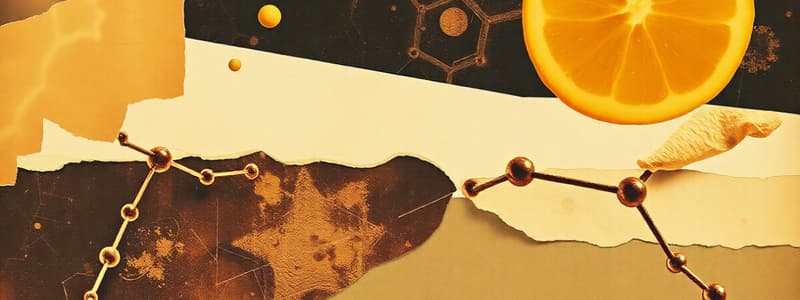Podcast
Questions and Answers
Which of the following is a characteristic outcome of the Maillard reaction in food preparation?
Which of the following is a characteristic outcome of the Maillard reaction in food preparation?
- Reduction in protein content
- Increased water content
- Decreased acidity
- Development of brown color and complex flavors (correct)
In the Maillard reaction, what role do melanoidins play?
In the Maillard reaction, what role do melanoidins play?
- They inhibit the reaction in high-moisture environments.
- They act as enzymes to speed up the reaction.
- They are the primary sugars that initiate the browning process.
- They are long, polymeric compounds that contribute to the brown pigments in cooked foods. (correct)
Which pair of saccharides are most influential in initiating the Maillard reaction?
Which pair of saccharides are most influential in initiating the Maillard reaction?
- Ribose and Sucrose
- Starch and Cellulose
- Lactose and Maltose
- Glucose and Fructose (correct)
Why are sugars bound as glycosides less reactive in the Maillard reaction?
Why are sugars bound as glycosides less reactive in the Maillard reaction?
What is the primary reactive group from proteins that participates in the Maillard reaction?
What is the primary reactive group from proteins that participates in the Maillard reaction?
What is the initial reaction in the Maillard browning process?
What is the initial reaction in the Maillard browning process?
During the Maillard reaction, what process occurs during the 'dehydration of intermediary products' stage?
During the Maillard reaction, what process occurs during the 'dehydration of intermediary products' stage?
How does temperature influence the Maillard reaction?
How does temperature influence the Maillard reaction?
How does water content affect the Maillard reaction?
How does water content affect the Maillard reaction?
How do sulfur dioxide and sulfites inhibit browning?
How do sulfur dioxide and sulfites inhibit browning?
Flashcards
Maillard Reaction
Maillard Reaction
A reaction during cooking that produces brown color and flavors in foods like cooked meat and toasted bread.
Melanoidins
Melanoidins
Long, polymeric compounds formed during the Maillard reaction that give cooked food its brown color.
Saccharides in Maillard Reaction
Saccharides in Maillard Reaction
Glucose, fructose, ribose, lactose, maltose and sucrose.
Amino Groups in Maillard Reaction
Amino Groups in Maillard Reaction
Signup and view all the flashcards
Initial Maillard Reaction Stage
Initial Maillard Reaction Stage
Signup and view all the flashcards
Intermediate Maillard Reaction Stage
Intermediate Maillard Reaction Stage
Signup and view all the flashcards
Final Maillard Reaction Stage
Final Maillard Reaction Stage
Signup and view all the flashcards
Factors Affecting Maillard Reactions
Factors Affecting Maillard Reactions
Signup and view all the flashcards
Sulfur Dioxide and Sulfites
Sulfur Dioxide and Sulfites
Signup and view all the flashcards
Caramelization
Caramelization
Signup and view all the flashcards
Study Notes
- Non-enzymatic browning reactions such as the Maillard reaction occur during cooking and are responsible for the brown color and flavors in foods like cooked meat, fried onions, roasted coffee, and toasted bread.
Maillard Reaction
- Melanoidins, which give cooked food its brown color, are the end products of the Maillard reaction.
- Reactants include saccharides (glucose, fructose, ribose, lactose, maltose, sucrose) and amino groups (proteins, guanidyl group, thiol group, biogenic amines, ammonium hydroxide, ammonium salts, amines).
- The reactive group in proteins is mainly the ɛ-amino group of lysine.
- Less reactive sugars are bound as glycosides, but their aglycones yield free reducing sugars upon heating.
- Other carbonyl sources can include sugar derivatives like ascorbic acids and oxidized lipids.
Three Stages of the Maillard Browning Reaction
- Amine reacts with a reducing sugar to form a glycosyl amine, followed by the Amadori rearrangement
- Dehydration and fragmentation of intermediary products such as the saccharidic moiety, and Strecker degradation of the products
- Reactions of intermediary products result in heterocyclic flavor compounds and high molecular weight brown pigments
Factors Affecting the Maillard Reactions
- Temperature affects the rate and mechanism; activation energy ranges between 10 and 160kJ/mol; rate increases with temperature, up to water activity of 0.3-0.7
- Low water content slows reaction; and high water content lowers reactant concentration
- Rate increases with pH until it reaches its maximum in a slightly alkaline medium.
- Sulphur dioxide and sulfites inhibit browning because sulfites react with aldehyde and keto groups or sugars and decrease their reactivity
Caramelization
- Complex group of reactions occur when heating carbohydrates (sucrose and reducing sugars) without nitrogen-containing compounds
- Reaction is facilitated by small amounts of acids and salts.
- The final product of caramelization is a complex mixture of polymeric compounds made from unsaturated, cyclic (five- and six-membered ring) compounds, as well as flavor and aroma compounds.
- Heating causes dehydration and formation of anhydro rings; 3-deoxyosones and furans are also formed as intermediates.
- Unsaturated rings condense to form conjugated double-bond-containing, brown polymers.
- Catalysts increase the reaction rate and can direct the reaction to specific attributes, such as caramel colors, solubilities, and acidities.
Commercial Production of Caramel
- Dark-brown liquid produced by heat-induced caramelization of carbohydrates, acts as a a coloring and flavoring agent
- Sucrose, d-fructose, d-glucose (dextrose) invert sugar, glucose syrups, HFCS, malt syrups, and molasses are the most often used carbohydrates
- Food-grade acids used acids include sulfuric, sulfurous, phosphoric, acetic, and citric acids
- Bases used include ammonium, sodium, potassium, and calcium hydroxide
- Used Salts may include ammonium, sodium, and potassium carbonates, bicarbonates, phosphates (mono- and dibasic), sulfates and bisulfites
Caramel Classifications
- Plain caramel is stable in alcohol, tannin, and salt-rich environments, with a strong aftertaste/mild aroma and color range from yellow to red.
- Caustic sulfite caramel has a mild flavor/aroma, exceptional red tone, and good stability in alcohol.
- Ammonia caramel has a sweet aroma, red-brown color, and is stable in alcohol and salt-rich environments.
- Sulfite ammonia caramel has a very mild flavor/aroma, rich dark brown color, and is stable in alcohol, tannin, and acid-rich environments.
Studying That Suits You
Use AI to generate personalized quizzes and flashcards to suit your learning preferences.




